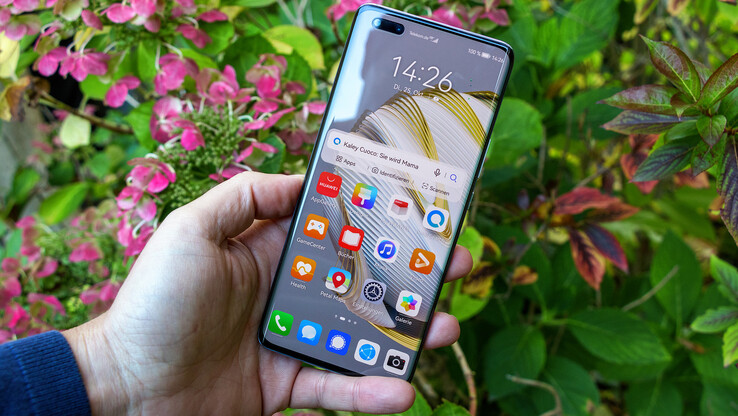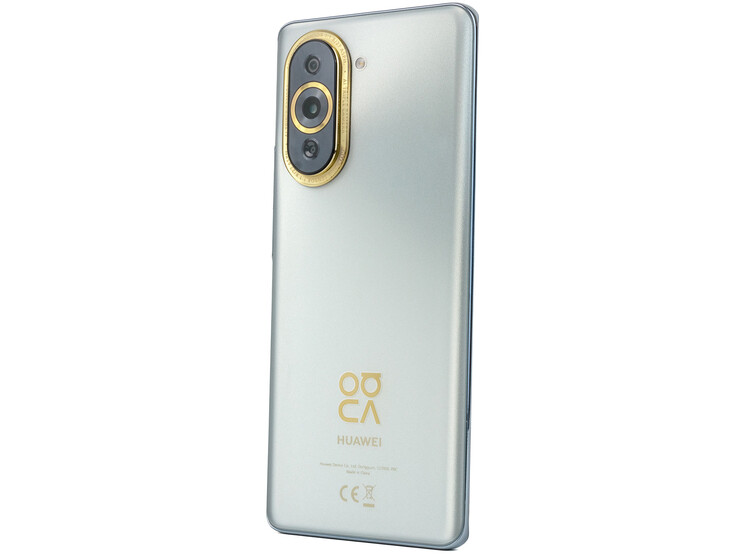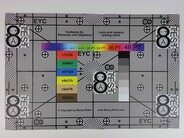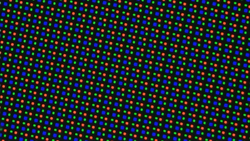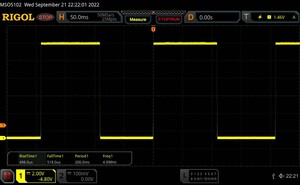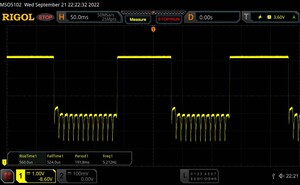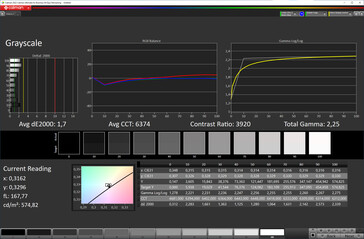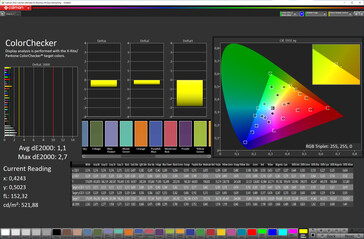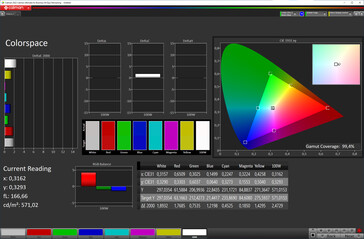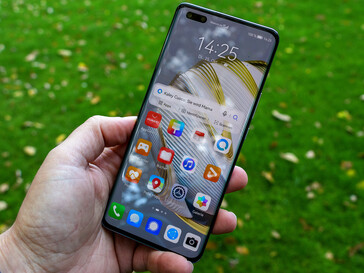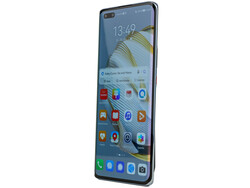Huawei Nova 10 Pro review - High-end smartphone with 60 MP selfie camera
Possible competitors in comparison
Rating | Date | Model | Weight | Drive | Size | Resolution | Best Price |
|---|---|---|---|---|---|---|---|
| 86 % | 12/2022 | Huawei Nova 10 Pro SD 778G 4G, Adreno 642L | 191 g | 256 GB UFS 3.1 Flash | 6.78" | 2652x1200 | |
| 89.3 % | 05/2022 | Samsung Galaxy S22 Exynos 2200, Xclipse 920 | 167 g | 128 GB UFS 3.1 Flash | 6.10" | 2340x1080 | |
| 87 % | 08/2022 | OnePlus 10T SD 8+ Gen 1, Adreno 730 | 203.5 g | 256 GB UFS 3.1 Flash | 6.70" | 2412x1080 | |
| 87.4 % | 10/2022 | Motorola Edge 30 Fusion SD 888+ 5G, Adreno 660 | 172 g | 128 GB UFS 3.1 Flash | 6.55" | 2400x1080 |
Case and features - Huawei smartphone with a chic design
Despite its quite high weight, the Huawei Nova 10 Pro makes a slim impression in the hand. This is due to the rounded display edges on the long sides. Although the camera setup clearly protrudes from the casing and looks quite bulky, the smartphone is still well-balanced.
The matte back is insensitive to fingerprints and looks chic, but it does not feel as high-quality as we would expect from a smartphone in this price range. The build quality on the other hand is really good. The gaps are tight and even. Only the SIM slot's cover is slightly recessed in the frame and does not close flush. There is a rubber seal on the SIM slot, but the Nova 10 Pro does not have a designated IP certification.
In general, the Nova 10 Pro lacks a few premium features in terms of equipment. Besides the lack of IP certification, we would have liked to see wireless charging, a more modern USB standard, or at least an IR blaster.
Communication, software and operation - Nova 10 Pro still with Android 11
Huawei's Nova 10 Pro does not use 5G, but it supports LTE with a broad frequency band coverage. The reception properties are good in metropolitan environments, but Nova's mobile data connection (download: 161 Mbit/s, upload: 17.3 Mbit/s) was slower than that of the Motorola Edge 30 Fusion (LTE, download: 212 MBit/s, upload: 26.6 MBit/s). The telephony features can convince in the test. The user's voice is rendered very naturally and lighter interfering noises are suppressed reliably.
The connection to the WLAN succeeds in a Wi-Fi 6 network at best. The Huawei smartphone manages stable transfer rates with our reference router Asus ROG Rapture GT-AXE11000.
The Nova 10 Pro runs Huawei's EMUI 12 (Harmony OS 2.0), which is based on Android 11. The manufacturer restrained itself from distributing updates during the test period because the security patches are still up to July 1, 2022. It is not yet clear if and when the update to EMUI 13 (Android 12) will be available. Like all Huawei phones in the meantime, the Nova 10 Pro has to do without Google services. However, a DRM certification is available.
An optical fingerprint scanner integrated into the display is available for biometric security. It recognizes the stored limb very reliably and works quite quickly. Two-dimensional face recognition is also available.
| Networking | |
| iperf3 transmit AXE11000 | |
| Huawei Nova 10 Pro | |
| OnePlus 10T | |
| Motorola Edge 30 Fusion | |
| Samsung Galaxy S22 | |
| iperf3 receive AXE11000 | |
| OnePlus 10T | |
| Motorola Edge 30 Fusion | |
| Huawei Nova 10 Pro | |
| Samsung Galaxy S22 | |
| iperf3 transmit AXE11000 6GHz | |
| Motorola Edge 30 Fusion | |
| iperf3 receive AXE11000 6GHz | |
| Motorola Edge 30 Fusion | |
Camera - Nova 10 Pro with 60 MP for selfies
A highlight of the Huawei Nova 10 Pro is the dual front-facing camera that not only offers a high resolution but also has both lenses equipped with autofocus. The selfies have a natural color reproduction, many filters, and a comprehensive beauty mode. They can also convince in terms of details. Videos are recorded in Ultra HD with up to 30 FPS at best.
The triple camera on the back uses a 50-MP RYYB sensor. It is characterized by a homogeneous color reproduction and a high detail level. The dynamic range is quite high, but the details suffer. Huawei also adds a depth-of-field lens and an ultra-wide-angle lens. The latter can also be used as a macro lens.
Again, videos are recorded in Ultra HD with 30 FPS at best. At least the main camera could have recorded a few more frames per second.
Image Comparison
Choose a scene and navigate within the first image. One click changes the position on touchscreens. One click on the zoomed-in image opens the original in a new window. The first image shows the scaled photograph of the test device.
Main cameraMain cameraUltra wide-angle5x ZoomLow-Light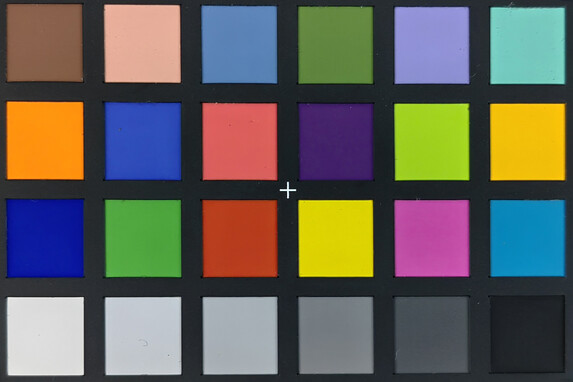
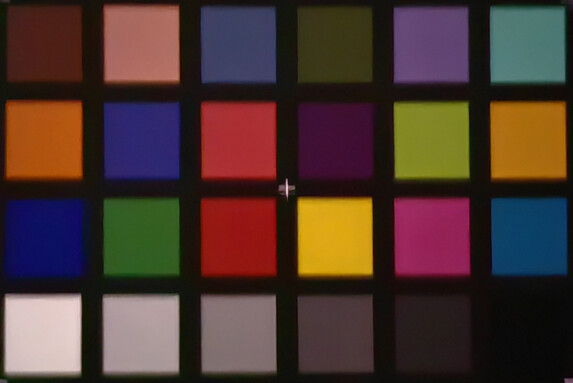
Display - Bright 120 Hz OLED in Huawei Nova 10 Pro
The 6.78-inch OLED screen of Huawei's Nova 10 Pro uses an unusual resolution, but it provides a high pixel density when it is enabled in the settings. The refresh rate can reach 120 Hz. This is either controlled automatically by the system or can be set to 60 or 120 Hz by the user.
The panel shines with up to 811 cd/m² in a pure white display and activated ambient light sensor. With an even distribution of dark and bright areas (APL18), it reaches a maximum peak luminance of 869 cd/m². Those who prefer to adjust the brightness manually have up to 571 cd/m² at their disposal.
We can measure flickering between 460 and 532 Hz below 44% of the adjustable luminance with the oscilloscope. Above this mark, flickering can only be detected at the level of the frame rate of 120 Hz.
| |||||||||||||||||||||||||
Brightness Distribution: 97 %
Center on Battery: 798 cd/m²
Contrast: ∞:1 (Black: 0 cd/m²)
ΔE Color 1.1 | 0.5-29.43 Ø5
ΔE Greyscale 1.7 | 0.57-98 Ø5.3
99.4% sRGB (Calman 2D)
Gamma: 2.25
| Huawei Nova 10 Pro OLED, 2652x1200, 6.78 | Samsung Galaxy S22 AMOLED, 2340x1080, 6.10 | OnePlus 10T Fluid AMOLED, 2412x1080, 6.70 | Motorola Edge 30 Fusion pOLED, 2400x1080, 6.55 | |
|---|---|---|---|---|
| Response Times | -255% | -23% | 18% | |
| Response Time Grey 50% / Grey 80% * | 1.08 ? | 8.486 ? -686% | 1.3 ? -20% | 1.19 ? -10% |
| Response Time Black / White * | 1.02 ? | 1.275 ? -25% | 1.2 ? -18% | 0.79 ? 23% |
| PWM Frequency | 532 | 239.8 -55% | 360.8 -32% | 753 42% |
| Screen | -15% | -36% | 1% | |
| Brightness middle | 798 | 853 7% | 861 8% | 954 20% |
| Brightness | 802 | 858 7% | 856 7% | 961 20% |
| Brightness Distribution | 97 | 96 -1% | 97 0% | 98 1% |
| Black Level * | ||||
| Colorchecker dE 2000 * | 1.1 | 1.9 -73% | 2.27 -106% | 1.5 -36% |
| Colorchecker dE 2000 max. * | 2.7 | 3.2 -19% | 4.17 -54% | 2.5 7% |
| Greyscale dE 2000 * | 1.7 | 1.9 -12% | 2.9 -71% | 1.8 -6% |
| Gamma | 2.25 98% | 2.07 106% | 2.303 96% | 2.24 98% |
| CCT | 6374 102% | 6460 101% | 6141 106% | 6254 104% |
| Total Average (Program / Settings) | -135% /
-95% | -30% /
-32% | 10% /
7% |
* ... smaller is better
Display Response Times
| ↔ Response Time Black to White | ||
|---|---|---|
| 1.02 ms ... rise ↗ and fall ↘ combined | ↗ 0.498 ms rise | |
| ↘ 0.518 ms fall | ||
| The screen shows very fast response rates in our tests and should be very well suited for fast-paced gaming. In comparison, all tested devices range from 0.1 (minimum) to 240 (maximum) ms. » 2 % of all devices are better. This means that the measured response time is better than the average of all tested devices (21.5 ms). | ||
| ↔ Response Time 50% Grey to 80% Grey | ||
| 1.08 ms ... rise ↗ and fall ↘ combined | ↗ 0.56 ms rise | |
| ↘ 0.524 ms fall | ||
| The screen shows very fast response rates in our tests and should be very well suited for fast-paced gaming. In comparison, all tested devices range from 0.2 (minimum) to 636 (maximum) ms. » 2 % of all devices are better. This means that the measured response time is better than the average of all tested devices (33.8 ms). | ||
Screen Flickering / PWM (Pulse-Width Modulation)
| Screen flickering / PWM detected | 532 Hz | ||
The display backlight flickers at 532 Hz (worst case, e.g., utilizing PWM) . The frequency of 532 Hz is quite high, so most users sensitive to PWM should not notice any flickering. In comparison: 53 % of all tested devices do not use PWM to dim the display. If PWM was detected, an average of 17933 (minimum: 5 - maximum: 3846000) Hz was measured. | |||
Measurement series with fixed zoom level and different brightness settings
Performance, emissions and battery life - No speed frenzy
The Huawei Nova 10 Pro works with a Snapdragon 778G 4G which is nominally identical to the 778G 5G but without the 5G functionality. The SoC has 8 GB of LPDDR5 RAM at its disposal, while the integrated Adreno 642L is responsible for the graphics calculations.
The UFS 3.1 memory is fast, but it is apparently slowed down by the SoC and sometimes remains significantly below the standard's capabilities. However, this will not be noticeable in everyday use.
The Nova 10 Pro is on the expected level in the benchmarks and delivers a good everyday performance. Most games should be playable smoothly without major losses in the detail level.
The two speakers deliver a decent sound, but they are a bit thin and lack power at higher volumes. Headphones or external speakers can be connected via the USB-C port. Bluetooth 5.2 is available wirelessly, but it does not support Qualcomm's aptX codecs.
The 4,500 mAh battery enables good battery runtimes for Huawei's Nova 10 Pro. It can be fully recharged in just under half an hour with the included 100-watt power adapter.
| Huawei Nova 10 Pro | Samsung Galaxy S22 | OnePlus 10T | Motorola Edge 30 Fusion | Average 256 GB UFS 3.1 Flash | Average of class Smartphone | |
|---|---|---|---|---|---|---|
| AndroBench 3-5 | 20% | 2% | 20% | 37% | 22% | |
| Sequential Read 256KB | 1013.91 | 1486 47% | 1568.37 55% | 1870.18 84% | 1760 ? 74% | 1505 ? 48% |
| Sequential Write 256KB | 846.82 | 993 17% | 847.69 0% | 689.24 -19% | 1134 ? 34% | 1112 ? 31% |
| Random Read 4KB | 218.19 | 273 25% | 173.45 -21% | 248.86 14% | 281 ? 29% | 247 ? 13% |
| Random Write 4KB | 280.18 | 257.6 -8% | 211.24 -25% | 276.74 -1% | 311 ? 11% | 271 ? -3% |
Temperature
(+) The maximum temperature on the upper side is 34.8 °C / 95 F, compared to the average of 35 °C / 95 F, ranging from 21.9 to 56 °C for the class Smartphone.
(+) The bottom heats up to a maximum of 34 °C / 93 F, compared to the average of 33.8 °C / 93 F
(+) In idle usage, the average temperature for the upper side is 31.1 °C / 88 F, compared to the device average of 32.7 °C / 91 F.
Speaker
Huawei Nova 10 Pro audio analysis
(+) | speakers can play relatively loud (83.8 dB)
Bass 100 - 315 Hz
(-) | nearly no bass - on average 20.7% lower than median
(±) | linearity of bass is average (10.7% delta to prev. frequency)
Mids 400 - 2000 Hz
(+) | balanced mids - only 3.6% away from median
(+) | mids are linear (5.8% delta to prev. frequency)
Highs 2 - 16 kHz
(+) | balanced highs - only 4.3% away from median
(+) | highs are linear (3% delta to prev. frequency)
Overall 100 - 16.000 Hz
(±) | linearity of overall sound is average (16% difference to median)
Compared to same class
» 3% of all tested devices in this class were better, 4% similar, 93% worse
» The best had a delta of 12%, average was 38%, worst was 134%
Compared to all devices tested
» 21% of all tested devices were better, 5% similar, 75% worse
» The best had a delta of 4%, average was 25%, worst was 134%
Motorola Edge 30 Fusion audio analysis
(+) | speakers can play relatively loud (88.9 dB)
Bass 100 - 315 Hz
(-) | nearly no bass - on average 24.9% lower than median
(±) | linearity of bass is average (8.1% delta to prev. frequency)
Mids 400 - 2000 Hz
(+) | balanced mids - only 2.9% away from median
(+) | mids are linear (4.5% delta to prev. frequency)
Highs 2 - 16 kHz
(+) | balanced highs - only 3.4% away from median
(+) | highs are linear (3.2% delta to prev. frequency)
Overall 100 - 16.000 Hz
(+) | overall sound is linear (14.7% difference to median)
Compared to same class
» 1% of all tested devices in this class were better, 1% similar, 98% worse
» The best had a delta of 12%, average was 38%, worst was 134%
Compared to all devices tested
» 15% of all tested devices were better, 4% similar, 81% worse
» The best had a delta of 4%, average was 25%, worst was 134%
Battery life
| Battery Runtime - WiFi Websurfing | |
| Average of class Smartphone (424 - 2844, n=224, last 2 years) | |
| OnePlus 10T | |
| Motorola Edge 30 Fusion | |
| Samsung Galaxy S22 | |
| Huawei Nova 10 Pro | |
Pros
Cons
Verdict - An expensive niche smartphone
Technically, Huawei delivers a good smartphone with the Nova 10 Pro, which also impresses with its appealing looks. A good camera is also found on both sides, fast charging is on board, and the display also delivers good results in the test.
The Huawei Nova 10 Pro gets in its own way with its ambitious price
However, there are a few bucks to swallow for an MSRP beyond 700 Euros. The Snapdragon 778G is not quite up to date anymore and does not support 5G. The EMUI does not seem to be maintained very enthusiastically, either. Version 12 still works with Android 11 and the last security patches were released a while ago. Not to mention the missing Google services.
Therefore, it is probably not that surprising that Huawei backs out and takes the Nova 10 Pro off the market again. The information is still available on Huawei's website but it is no longer available for purchase there. Strong alternatives are the Galaxy S22 or the Motorola Edge 30 Fusion.
Price and availability
Huawei Nova 10 Pro
-
12/02/2022 v7
Daniel Schmidt


 Deutsch
Deutsch English
English Español
Español Français
Français Italiano
Italiano Nederlands
Nederlands Polski
Polski Português
Português Русский
Русский Türkçe
Türkçe Svenska
Svenska Chinese
Chinese Magyar
Magyar